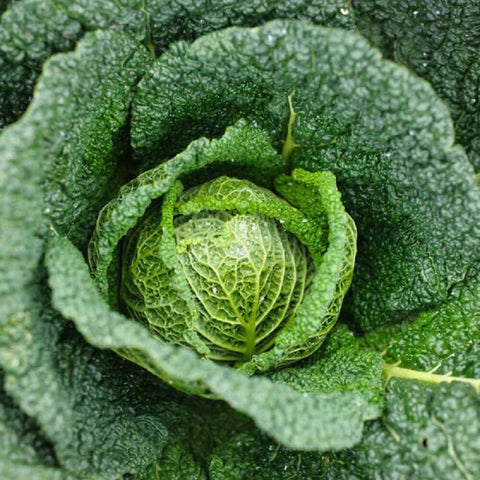

Hortinova
VERTUS - Open Pollinated Heirloom Savoy Cabbage Seeds
Brassica oleracea var. capitata
- Mid-late maturity : 90 – 95 days.
- Round shaped head with crinkly leaves.
- Head weight : 1.5 – 1.8 Kg.
- Heirloom variety originated in France.
- Juicy, semi-sweet, mild cabbage flavor.
- Open-pollinated seeds.
- Natural, Untreated, Non-GMO Seeds.
For a summer harvest, start seeds indoors, sowing about 6 to 8 weeks before the last spring frost.
For a fall harvest, direct sow seeds outdoors (or plant transplants) in mid- to late summer. If your area is particularly hot and dry, hold off on planting until late summer. Make sure that the young plants don’t dry out in the summer sun’s heat.
SOWING IN CELLS: Sow single seeds ½ in (1 cm) deep into the center of cells filled with seed-starting mix. Cover them with mix, water, label, and let them germinate on a cool, bright windowsill or in a sheltered position outdoors. Cabbages sown in cells will be ready to plant out in about four weeks.
SOWING INTO THE SOIL: To raise plants for transplanting, find space for a row 2—3 ft (60-90 cm) long. Rake the soil in this seedbed to a fine, crumbly texture and, using a trowel, create a trench ½ in (1 cm) deep. Sow the seeds thinly along the row, cover with soil, water thoroughly, and label. Where there is room in the garden, spring cabbages can also be sown in their final position. In this event, sow them thinly along rows 12 in (30 cm) apart.
THIN: When seedlings reach about 5 inches tall, thin to leave the desired space between them. If you wish, transplant the thinned seedlings elsewhere.
PLANT OUT: Before planting the seedlings outdoors, harden off the plants over the course of a week. Choose a planting site with fertile, slightly alkaline soil that gets full sun (6 to 8 hours of direct sunlight per day) in order to get the best results. Transplant seedlings outdoors on a cloudy afternoon 2 to 3 weeks before the last spring frost date. Water well before pushing plants out of their cells or carefully lifting those grown in the soil with a hand fork. Plant out in rows 12 in (30 cm) apart, at 12 in (30 cm) intervals.
TEMPERATURE: The optimum soil temperature for growth is 60°F to 65°F (15°C to 18°C). Young plants exposed to temperatures below 45°F (7°C) for a period of time may bolt or form loose heads. Cover plants if cold weather is expected.
WATER & FEED: Cabbage is a heavy feeder; it quickly depletes the soil of nutrients and needs a steady supply of water and nutrients throughout its growth. Prepare the soil in advance by mixing in aged manure and/or compost. Soil should also be well-draining: roots that stand in water cause heads to split or rot. Water 2 inches per square foot per week. Fertilize 2 weeks after transplanting with a balanced (10-10-10) fertilizer. Three weeks later, add a nitrogen-rich fertilizer; cabbage needs nitrogen in the early stages.
PROTECT: Grow young plants under fleece or mesh to protect against cabbage root fly and flea beetles; root flies will also be deterred using “cabbage collars” — disks that shield the soil at the base of the plant. Create barriers and traps around plants to control slugs and snails. Netting stretched over supports will keep hungry pigeons away. Mulch thickly around the area to retain moisture and regulate soil temperature. Practice crop rotation with cabbages to avoid a buildup of soil-borne diseases.
Harvest when heads reach desired size and are firm. Mature heads left on the stem may split. Days to maturity is around 70 days for most green cabbage varieties and most produce 1- to 3-pound heads.
To harvest, cut each cabbage head at its base with a sharp knife. Remove any yellow leaves (retain loose green leaves; they provide protection in storage) and immediately bring the head indoors or place it in shade. Alternatively, pull up the plant (roots and all) and hang it in a moist cellar that reaches near-freezing temperatures.
To get two crops, cut the cabbage head out of the plant, leaving the outer leaves and root in the garden. The plant will send up new heads; pinch off those until only four or so smaller heads remain. Harvest when tennis ball-size (perfect for salads!).
After harvesting, remove the entire stem and root system from the soil to prevent disease. Only compost healthy plants; destroy any with maggot infestation.
Let customers speak for us
from 23 reviewsWe grow several varieties of various colours of tomatoes, and the contrast of these tomatoes with other colours is fantastic. We've had a very long season with our plants, excellent disease resistance, great flavour.

This review applies to all of the seeds I purchased from Hortinova - beautiful tomatoes, good disease resistance and excellent production. Our field season extended to 10 weeks. We've had comments of excellent flavour from our customers as well, highly recommend any Hortinova seed.

This tomato is good taste tomato. Small red round tomato. Bigger then cherry tomatoes but smaller then regular one. I like it. Perfect for salads and fresh eating. Ordered seeds for next season.

2nd time ordering. Very satisfied with qualify and result. Thank you

BALCONY YELLOW F1 - Hybrid Cherry Tomato Seeds

Delivered very fast, packed very good, in professional condition and quality. Thanks

DUETT - Open Pollinated Radish Seeds

We will see what they are like this summer.

Type crimson de bonne grosseur avec une superbe uniformité et très hâtif. Un des premiers prêt en saison. Semences très petites et peu nombreuses. Goût très sucré et chaire croquante. Chair passant du rose au rouge en cours de saison. Les plants sont forts et très vigoureux avec des grosses feuilles.

Vigueur des plants impressionante avec des fruits résistants aux fissures et aux dommages. Très bonne conservartion et goût très sucré lorsque les nervures deviennent orange. Peu être récolté lorsque les nervures sont vertes également. Cavité des semences très compacte et petite laissant beaucoup de chair.

Melon qui fond en boûche avec un goût se rapprochant du melon miel et du cantaloup à la fois, très sucré. Faire attention aux irriguations lorsque le melon devient mature car il peut fendre au champs. Très odorant.

Avec son apparence côtellée, son très gros calibre et ça couleur rose, cette tomate se démarque des autres sur les tablettes. Variété plus résistante à la pourriture apicale que la plus part des autres tomates roses. Bon ensemble de résitance aux maladies également.

Tomate noire dont les faces qui ne sont pas exposé au soleil passent du vert au rouge lorsque mature donnant un aspect unique aux fruits. Charactéristiques similaires à la Barrio avec un goût superbe sans acide. Les clients l'on adoré.

Superbe adaptabilité et excellente résistance aux maladies. Fruits uniformes qui ne fendent pas, bonne conservation. Ajoutez à cela un goût unique avec une légère acidité et une pointe sucré.















